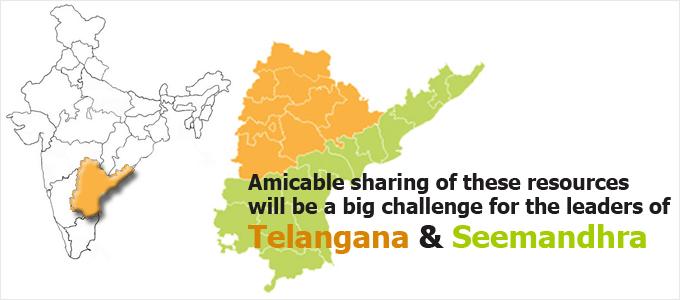|
With the passage of the Andhra Pradesh Reorganization bill or the Telangana Bill by the Lok Sabha, in February 2014, and subsequent clearance of the same in the Rajya Sabha, India’s 29th state — Telangana - was officially established. The elongated struggle for a separate statehood stunted the growth of the region. Further, the agitation which intensified in the last couple of years also affected the flow of project investment into this natural resources-rich area of the undivided Andhra Pradesh.

The demand for a separate state of Telangana was made long back in the 1960s and 1970s. However, it failed to gather enough momentum in the 1980s and 1990s. After a lull of almost two decades the movement revived in 2001, resulting in a series of agitations for and against the formation of Telangana state. This eventually led to July 2013, when the Congress Working Committee resolved to proceed with the division of the state.
The Telangana state consists of ten districts - Hyderabad, Adilabad, Khammam, Karimnagar, Mahaboobnagar, Medak, Nalgonda, Nizamabad, Rangareddy, and Warangal. The region is home to India's 20 per cent coal deposits. 45 per cent of Andhra's forest area, and 41.6 per cent of AP's population are in Telangana. 45 per cent of the state income comes from Telangana region. Telangana also has limestone, bauxite and mica deposits.
Seemandhra, which is Rayalaseema and Coastal Andhra combined, consists of 13 districts - Kurnool, Chittoor, Kadapa, Anantapur, East Godavari, West Godavari, Krishna, Guntur, Prakasam, Nellore, Srikakulam, Vizianagaram, and Visakhapatnam. The region is endowed with the largest seacoast on the Bay of Bengal, with major ports like Visakhapatnam, Gangavaram and Krishnapatnam.
The current dynamics of these resources will change drastically with the bifurcation of the state. Amicable sharing of these resources will be a big challenge for the leaders of both the new states.
Water resource sharing is also going to be a tricky issue post separation. While perennial rivers Godavari and Krishna, as well as smaller rivers like Musi, Bhima, Kinnerasani and Pen Ganga flow in through Telangana, most of Andhra’s irrigation projects, including the Pranahita-Chevella Lift Irrigation project are located in Seemandhra. As per the Telangana Bill, after the split, the execution of ongoing projects and envisaged new projects on Krishna and Godavari rivers shall be the responsibility of the successor state governments concerned where the project is located.
The status of Hyderabad post separation has also been the bone of contention between Telangana and Seemandhra. Hyderabad is a hub of information technology (IT) and pharmaceutical industries, and is amongst the largest recipients of foreign direct investment in India. On 7 February 2014, the Union cabinet cleared the Telangana bill, rejecting Seemandhra leaders' demands to make Hyderabad a union territory. As per the bill, Hyderabad will serve as a joint capital of Telangana and Seemandhra for 10 years.
The spotlight will now be on cities in Seemandhra which can be developed to be the future capital. Consequently, Vizag, the second largest city in Andhra Pradesh, is being said to be the natural choice. With an airport, seaport, and well connected road and railway network, the city already has the needed infrastructure. Other major cities like Vijayawada-Guntur, Ongole, Kurnool, Rajahmundry and Tirupati are also contenders for the capital status of the new state.
Projex: Telangana vs. Seemandhra
Despite the political turmoil in Andhra Pradesh due to the Telangana issue, the state managed to attract over $2 billion worth of investments in the last 18 months across sectors. Some of the major projects recently announced in the state include Isuzu's investment of Rs 3,000 crore at Sri City; Vertex Cements’ proposed Rs 1,500 crore Cement unit in Guntur district; Johnson & Johnson’s Rs 450 crore unit in Mahaboobnagar district; and Procter & Gamble’s Rs 370 crore unit in Mahaboobnagar district etc.
As of 31 Jan 2014, Andhra Pradesh had over 4,075 live projects worth Rs 8,00,096 crore. Upcoming projects in Telangana include the Rs 16,375 crore Hyderabad metro project; Rs 7,200 crore Lanco Hills Technology Park project; and Sheshadri Power & Infrastructure’s Rs 7,000 crore coal-based power project.
As for Seemandhra, some big upcoming projects are HPCL’s Rs 45,000 crore Visakhapatnam Refinery-cum-Petrochemical capacity expansion project; NTPC’s Pudimadaka Ultra Mega Power Project worth Rs 24,000 crore; and Rashtriya Ispat Nigam’s Rs 19,800 crore capacity expansion at their Visakhapatnam project.
The Telangana Bill already stipulates that the Central government shall take appropriate fiscal measures, including tax incentives to the successor states in order to promote industrialization and economic growth in both the states. This is combined with a special development package for the backward regions of Seemandhra.
Overall, bifurcation of Andhra Pradesh is expected to see increased economic and business activities in both the states but there is a need for early resolution on sharing of resources along with state government policies and tax benefits.
Ever since the process of separation of Telangana was initiated, similar demands for separate states have been cropping up in other regions of India. The point that smaller states are better run than bigger ones is a valid one. However, the emphasis should be on amicably settling issues and laying the ground for new states to grow rapidly.
|